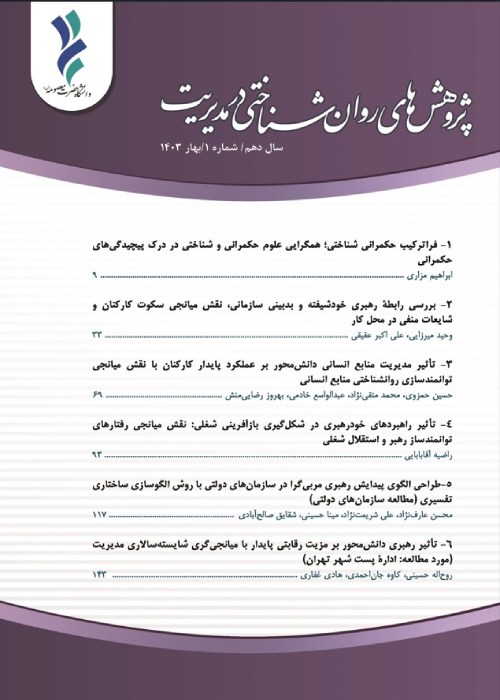Designing the emergence model of coaching leadership in government organizations with the interpretive structural modeling method (case study: government organizations)
Coaching leadership is one of the desirable and practical styles of leadership that has positive effects and consequences for the organization. Managers and leaders who manage and lead their organization with this style, bring about transformations and efficient individual, group, and organizational outcomes. In the coaching leadership style, there is a kind of commitment to the growth and development of people in the organization. This commitment is in line with the goals of coaching, which is the actualization of employees' abilities, talents, and potential capacities. Also, coaching leaders should develop strong competencies and skills in themselves and have faith and belief in their abilities to perform the task of coaching desirably. This leadership style also creates positive relationships between managers and employees and increases cooperation and coordination in the organization. Therefore, paying attention to the coaching leadership style in government organizations can facilitate the improvement of the performance and effectiveness of these organizations and help the government to provide the best services to the people. Based on this, the current research was conducted to design a model for the emergence of coaching leadership in government organizations with the interpretive structural modeling method.
Design/Methodology/Approach:
This research was conducted based on mixed research and qualitatively and quantitatively in the comparative inductive paradigm. This research is applied in terms of purpose and descriptive survey in terms of nature and method. The statistical population of the current research is experts including university professors in the field of organizational behavior management and human resource management, as well as senior managers of government organizations, whose sample members were selected using the snowball sampling method and based on the principle of theoretical adequacy. The data collection tool in the qualitative part is a semi-structured interview, whose validity and reliability were tested by content analysis and theoretical validity and intra-rater and inter-rater reliability. Also, the data collection tool is in the quantitative part of the questionnaire, the validity and reliability of which were measured by the method of content validity and retest reliability. In this research, content analysis and coding with Atlas software were used to analyze the data in the qualitative part. Also, for quantitative analysis, the interpretative structural modeling method was used.
The findings of this research include the factors influencing the formation of the phenomenon of coaching leadership and the presentation of its model. In the qualitative part of this research, through interviews with the experts of the desired data, the effective factors on coaching leadership have been identified. Regarding the method of coding and extraction of qualitative data, it should be mentioned that according to the nature of the questions and the way the experts answered, the words and phrases they mentioned were components related to coaching leadership. Then, in the quantitative part, by designing a questionnaire whose rows and columns were the effective factors in coaching leadership, the experts were asked to answer the questionnaires using the interpretive structural modeling method. Finally, by analyzing the data, the components' leveling and designing the model was done.
In the theories of management, managers find a more essential role every day than in the past. Also, from the organizational point of view, leaders are the most key and effective people whose proper and positive performance can make the employees and the organization successful. One of the new models of effective leadership in today's organizations is the coaching leadership model, which creates a supportive image of the leader in the mindset and attitude of employees, motivates human resources, and also organizational commitment. It is a positive development in the direction of improving the performance of employees and also increasing the productivity of the organization. The results of the research include the design of the emergence model of coaching leadership. In this research, the coaching leadership model has been formulated in four main levels based on the coaching leadership philosophy, the background, and context of coaching leadership formation, the dimensions of coaching leadership, and its consequences.
- حق عضویت دریافتی صرف حمایت از نشریات عضو و نگهداری، تکمیل و توسعه مگیران میشود.
- پرداخت حق اشتراک و دانلود مقالات اجازه بازنشر آن در سایر رسانههای چاپی و دیجیتال را به کاربر نمیدهد.


